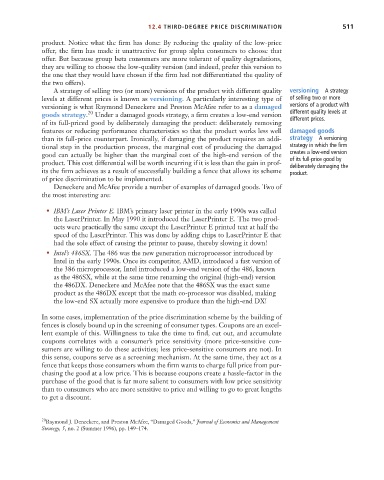Page 537 - Microeconomics, Fourth Edition
P. 537
c12capturingsurplus.qxd 7/22/10 10:41 AM Page 511
12.4 THIRD-DEGREE PRICE DISCRIMINATION 511
product. Notice what the firm has done: By reducing the quality of the low-price
offer, the firm has made it unattractive for group alpha consumers to choose that
offer. But because group beta consumers are more tolerant of quality degradations,
they are willing to choose the low-quality version (and indeed, prefer this version to
the one that they would have chosen if the firm had not differentiated the quality of
the two offers).
A strategy of selling two (or more) versions of the product with different quality versioning A strategy
levels at different prices is known as versioning. A particularly interesting type of of selling two or more
versioning is what Raymond Deneckere and Preston McAfee refer to as a damaged versions of a product with
goods strategy. 20 Under a damaged goods strategy, a firm creates a low-end version different quality levels at
of its full-priced good by deliberately damaging the product: deliberately removing different prices.
features or reducing performance characteristics so that the product works less well damaged goods
than its full-price counterpart. Ironically, if damaging the product requires an addi- strategy A versioning
tional step in the production process, the marginal cost of producing the damaged strategy in which the firm
good can actually be higher than the marginal cost of the high-end version of the creates a low-end version
product. This cost differential will be worth incurring if it is less than the gain in prof- of its full-price good by
deliberately damaging the
its the firm achieves as a result of successfully building a fence that allows its scheme product.
of price discrimination to be implemented.
Deneckere and McAfee provide a number of examples of damaged goods. Two of
the most interesting are:
• IBM’s Laser Printer E. IBM’s primary laser printer in the early 1990s was called
the LaserPrinter. In May 1990 it introduced the LaserPrinter E. The two prod-
ucts were practically the same except the LaserPrinter E printed text at half the
speed of the LaserPrinter. This was done by adding chips to LaserPrinter E that
had the sole effect of causing the printer to pause, thereby slowing it down!
• Intel’s 486SX. The 486 was the new generation microprocessor introduced by
Intel in the early 1990s. Once its competitor, AMD, introduced a fast version of
the 386 microprocessor, Intel introduced a low-end version of the 486, known
as the 486SX, while at the same time renaming the original (high-end) version
the 486DX. Deneckere and McAfee note that the 486SX was the exact same
product as the 486DX except that the math co-processor was disabled, making
the low-end SX actually more expensive to produce than the high-end DX!
In some cases, implementation of the price discrimination scheme by the building of
fences is closely bound up in the screening of consumer types. Coupons are an excel-
lent example of this. Willingness to take the time to find, cut out, and accumulate
coupons correlates with a consumer’s price sensitivity (more price-sensitive con-
sumers are willing to do these activities; less price-sensitive consumers are not). In
this sense, coupons serve as a screening mechanism. At the same time, they act as a
fence that keeps those consumers whom the firm wants to charge full price from pur-
chasing the good at a low price. This is because coupons create a hassle-factor in the
purchase of the good that is far more salient to consumers with low price sensitivity
than to consumers who are more sensitive to price and willing to go to great lengths
to get a discount.
20 Raymond J. Deneckere, and Preston McAfee, “Damaged Goods,” Journal of Economics and Management
Strategy, 5, no. 2 (Summer 1996), pp. 149–174.

